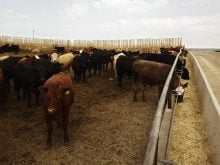BANFF, Alta. – Pork production has been increasing worldwide, but the high cost of feed grain threatens to slow down the North American
industry.
The booming biofuel industry is gobbling up more corn in the United States, driving up grain prices and lowering profits for the livestock sector.
Larry Martin, chief executive officer of the George Morris Centre, said this activity is causing a major shift in the agriculture sector, where manufacturers compete for corn to make food and fuel.
Martin expects the ethanol industry to keep growing as long as oil prices remain high and government subsidies continue to support biofuel. He also foresees a rough ride for pork producers throughout 2007 as their costs of production rise.
Read Also

Solar, sheep provide valuable farm diversification
Eric Steeves says raising sheep on forages grown under solar panels provided economic stability and perhaps even saved his family’s fifth generation southern Alberta grain farm.
In 2006, the United States produced 19 billion litres of ethanol from corn, which equals 11 to 12 days of oil imports. Twice as much corn will be needed to produce 38 billion litres.
“This level of production is probably feasible if oil prices stay high. I think they are going to stay high,” Martin said.
The ethanol industry will be able to outbid the livestock sector for corn if the trend continues, he said at the Banff Pork Seminar on Jan. 18.
“Ethanol producers could bid as much as $5 a bushel for corn and hog producers could bid about $3.50 to be at break even.”
Martin questioned how well byproducts from corn ethanol production would work as a feed ingredient for livestock. If these have to be disposed of, he added, there is no practical saving in using corn for fuel.
He suggested cellulose products are a better fit for ethanol production.
“In the long term if ethanol is going to be successful it is going to be successful using the cellulosic techniques or produce biodiesel from lower value products like palm oil,” he said.
The U.S. is already moving in that direction with a Jan. 24 announcement of a $1.6 billion US investment in new funding for renewable energy, with a focus on cellulosic energy research and production, as part of the 2007 farm bill proposals.
A news release from the U.S. Department of Agriculture said this latest funding will complement a variety of renewable energy-related efforts underway.
USDA spent nearly $1.7 billion on energy-related programs between 2001 and 2005. In 2006, USDA spent an estimated $270 million on these programs in areas such as commercialization, research, infrastructure development and technical support.
There are 110 operational ethanol plants in 19 states with another 73 under construction.















